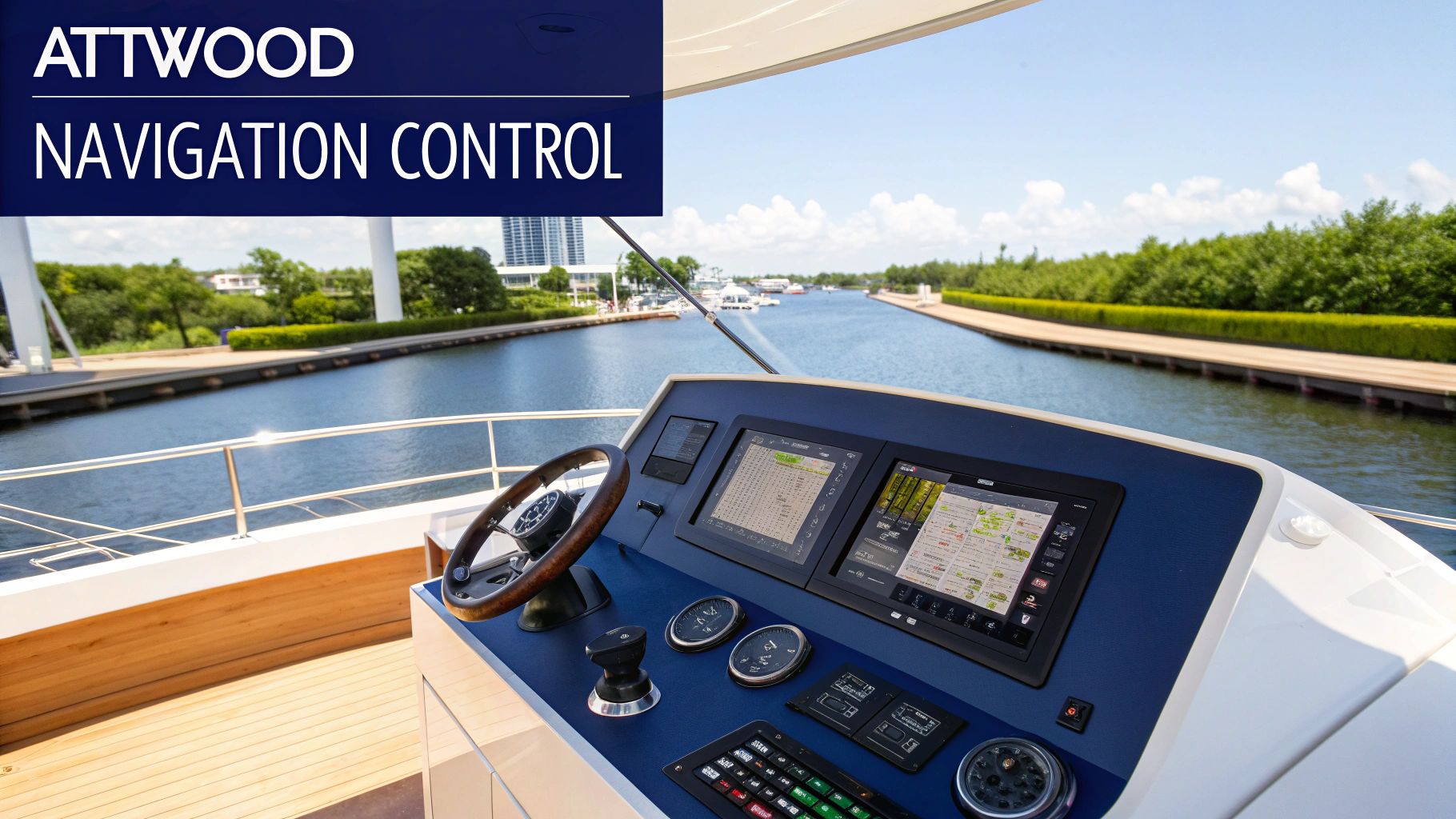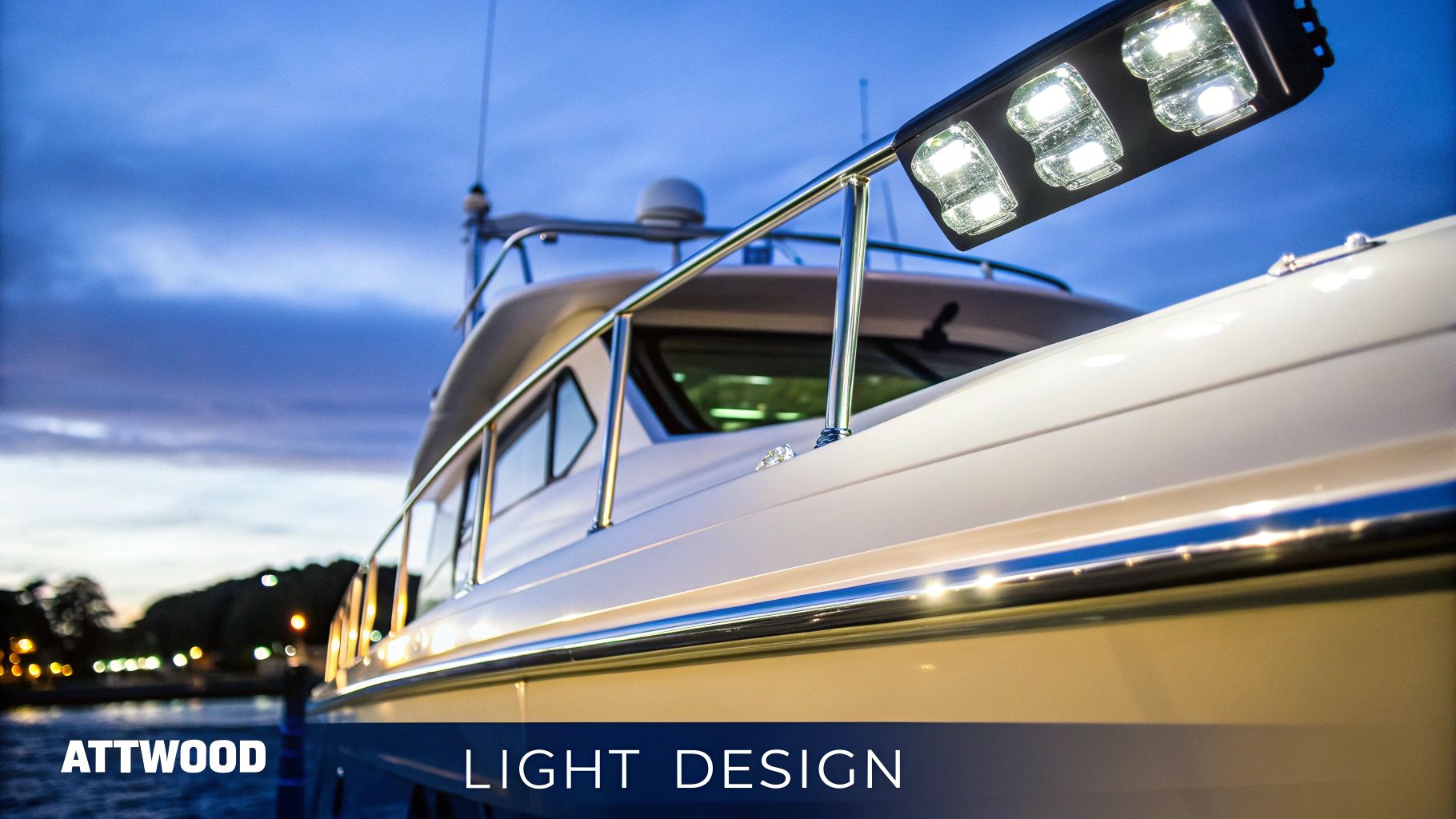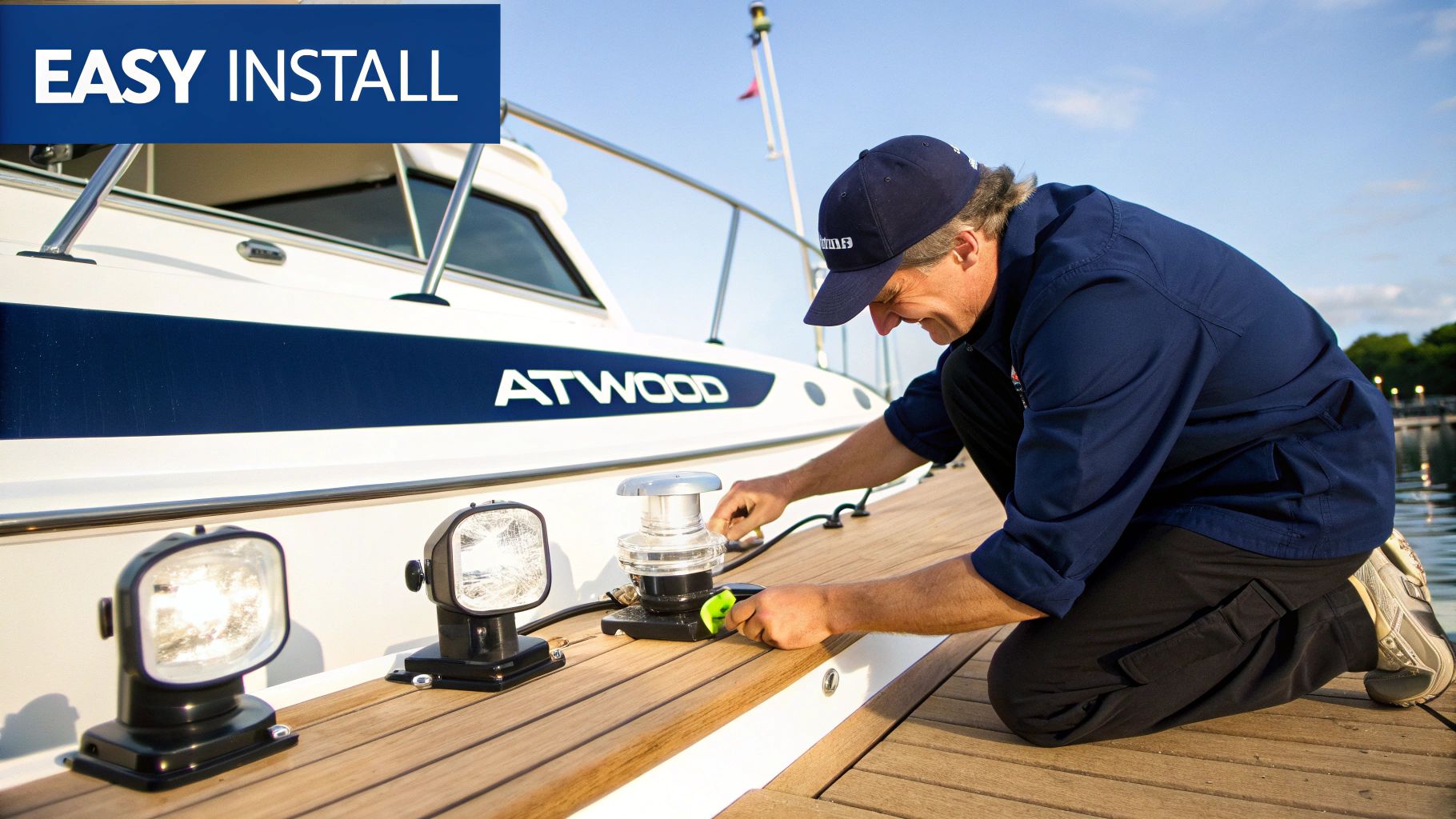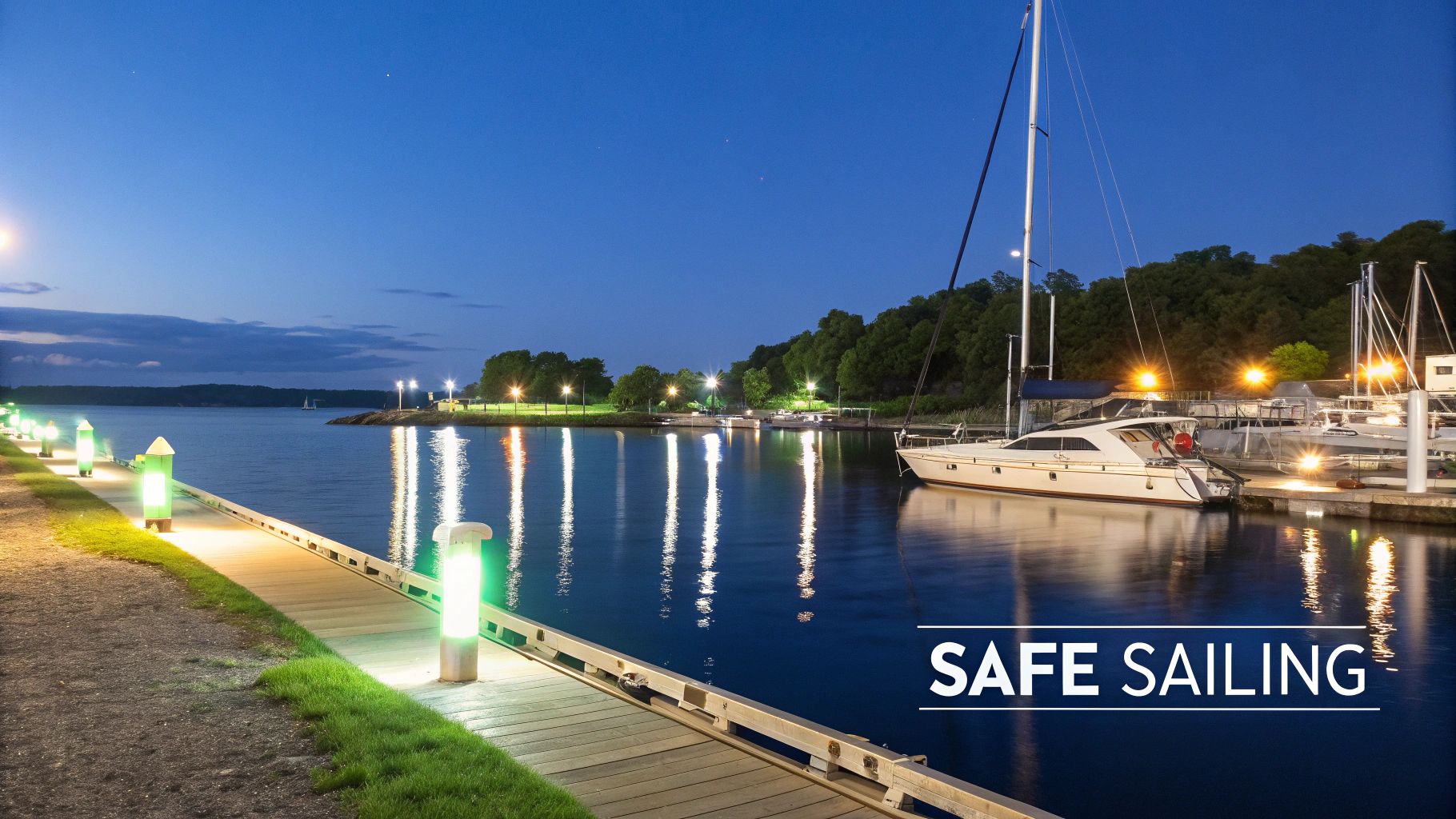Navigating the Basics: Essential Attwood Lighting Systems

Safe boating depends on proper lighting, especially at night. Attwood boat lights navigation systems give boaters a dependable and effective way to be seen better and stay safe on the water. These systems are important for more than just meeting regulations; they're vital for avoiding collisions and ensuring safe passage in low-light conditions. Knowing the kinds of lights you need and what they do is the first step.
Understanding Navigation Light Requirements
Lighting requirements change depending on the size and type of vessel. Smaller vessels under 12 meters (39.4 feet) usually need a masthead light, sidelights (red and green), and a sternlight. Larger vessels might need more, like all-round lights or special masthead lights for those over 50 meters (164 feet). Choosing the right Attwood lighting system is key. For more product information, check out the Attwood product sitemap.
Choosing the Right Attwood Lighting System
Attwood offers a wide selection of navigation lights made for different needs. Their products use advanced lens technology and smart light placement for the best visibility. This means boaters can find an Attwood system perfect for their boat and where they go boating. Attwood Marine has been a leader in the marine industry for over 100 years. They specialize in designing, making, testing, and selling marine products, including boat navigation lights. Their long history shows they know the market and its technology. Discover more insights about Attwood Marine.
Key Attwood Lighting Features
Attwood navigation lights have some important features. Durability is key in tough marine environments. Attwood builds strong, weatherproof lights to last. Many also use energy-efficient LED technology. This means they last longer and use less power. Easy installation is another benefit. Many models are designed for simple mounting and wiring.
To help you choose the right lights for your boat, we’ve put together a handy table summarizing the essential Attwood navigation lights by vessel type. This table makes it easy to see which lights you need and which Attwood models are recommended.
Essential Attwood Navigation Lights by Vessel Type
| Vessel Type/Size | Required Lights | Recommended Attwood Models |
|---|---|---|
| Under 7 meters (23 feet) | Masthead, Sidelights, Sternlight | Series 2000, Series 5500 |
| 7-12 meters (23-39.4 feet) | Masthead, Sidelights, Sternlight | Series 3000, Series 6600 |
| 12-20 meters (39.4-65.6 feet) | Masthead, Sidelights, Sternlight, All-Round Light | Series 4000, Series 7700 |
| Over 20 meters (65.6 feet) | Masthead, Sidelights, Sternlight, All-Round Light, Second Masthead | Series 5000, Series 8800 |
As you can see, the required lights and recommended models depend on your vessel’s size. Be sure to select the right system to ensure you're meeting all safety regulations.
Investing in good Attwood boat lights is an investment in safety and peace of mind. Knowing the lighting requirements and picking the right Attwood system ensures boaters are ready for safe and fun times on the water.
What Makes Attwood Navigation Lights Stand Out
Attwood boat lights navigation systems go beyond basic requirements. They represent a true dedication to safety and high performance on the water. Several key advantages set these lights apart from the competition. One major advantage is their durable weatherproofing. Attwood designs its lights to resist tough marine environments. They work reliably even in heavy rain, salt spray, and extreme temperatures. This robust design means fewer replacements and less maintenance overall.
Attwood also prioritizes power efficiency, an important factor for boaters. Many Attwood navigation lights use LED technology, which uses far less energy than traditional incandescent bulbs. This means longer battery life and a smaller environmental footprint.
For example, the Attwood LED Anchor/Steaming Light offers 3 nautical miles (NM) of 360° visibility. It's suitable for boats up to 65.6 feet (20 meters) long, all while using minimal power compared to older incandescent lights.
Precision Engineering and Design
Another standout feature is the precise engineering of Attwood's mounting systems. These systems are designed for stability and easy installation. The secure fit handles vibrations and impacts common during navigation. This stability ensures Attwood lights stay properly aligned, maximizing visibility and reducing the risk of misinterpretation by other boats.
Balancing Function and Aesthetics
Beyond just functionality, Attwood understands that aesthetics matter to boat owners. Their navigation lights are designed to look good on modern boats. This attention to detail means safety features won't compromise the vessel's appearance, something not all competitors achieve. The sleek designs of Attwood lights blend seamlessly with various boat styles. This provides a solution that's both practical and visually appealing.
In a market full of choices, Attwood navigation lights distinguish themselves through durability, efficiency, precise engineering, and thoughtful design. These features give boaters not just illumination, but also confidence and peace of mind.

LightArmor Series: Attwood's Premium Navigation Solution

The LightArmor series is Attwood's premium line of marine navigation lighting. Designed for boaters who demand reliable performance, these lights offer exceptional durability and innovative features. They represent a smart investment for any serious boater looking for long-lasting quality.
Durability and Material Science
Attwood uses special polymer compounds to construct the LightArmor series. These materials offer incredible durability, resisting the harsh marine environment. The housings withstand impacts, UV exposure, and saltwater corrosion much better than standard plastics. This ensures reliable performance even in extreme conditions.
Patented Lens Designs for Maximum Visibility
Attwood's patented lens designs maximize visibility on the water. These precisely engineered lenses efficiently focus the light, ensuring your boat is seen from a greater distance. This enhanced visibility is critical for safe navigation, especially in low-light or crowded areas. It gives other boaters ample time to react, improving overall safety on the water.
Innovative Mounting Systems for Simple Installation
The LightArmor series boasts innovative mounting systems that simplify installation. These mounts are designed for stability, keeping the lights secure even in rough seas. This combination of easy installation and robust stability makes them even more appealing to boaters. The lights also meet global regulatory requirements like EN/ISO 19009:2015, ensuring compliance with international navigation standards. Learn more about the Attwood LightArmor series here.
Real-World Performance and Testimonials
The LightArmor series performs exceptionally well in real-world conditions. Many commercial operators, who depend on their equipment daily, choose LightArmor lights. Their positive feedback highlights the series' reliability and performance in demanding environments, further emphasizing their value and durability.
Customization Options for Personalized Solutions
Attwood recognizes that boat lighting needs vary. The LightArmor series offers a range of customization options, allowing boaters to tailor a system to their specific requirements. Whether you need particular light colors, beam angles, or mounting solutions, Attwood provides the flexibility to create the perfect navigation setup for your boat and boating style. This personalized approach enhances both safety and on-the-water convenience.
Installing Attwood Navigation Lights Like a Pro

Proper installation of your Attwood boat lights navigation system is essential for both safety and performance. This guide, created with advice from marine electricians, will help you get it right the first time.
Planning Your Installation
Before starting, gather your tools and map out your wiring route. Think about easy access for any future maintenance. Selecting the correct wire gauge for your lights' current draw is important to avoid voltage drop. This ensures your lights shine brightly.
- Gather tools: Wire strippers, crimpers, heat shrink tubing, sealant, drill, screws, etc.
- Plan the route: Find a safe path that protects wiring from damage and weather.
- Select the correct wire gauge: Check Attwood's specifications for the right wire size.
Good preparation now will help prevent problems later.
Mounting Your Attwood Lights
The placement of your navigation lights is crucial for visibility and meeting regulations. Attwood lights offer various mounting options, so choose a location that is sturdy and provides the necessary visibility angles. Keep the following in mind:
- Visibility: Make sure your lights aren't blocked and are visible from the required angles.
- Structural integrity: Select a strong mounting point that can withstand vibrations and impacts.
- Accessibility: Ensure easy access to the lights for maintenance and bulb changes.
Correct mounting ensures long-lasting performance.
Making Watertight Connections
Water and electricity are a dangerous combination. Use marine-grade connectors and seal every connection to prevent corrosion and shorts. Heat shrink tubing provides extra protection, especially for connections exposed to the elements. Remember these key steps:
- Use marine-grade connectors: These are built to resist the harsh marine environment.
- Seal all connections: Use a good quality marine sealant to keep water out.
- Use heat shrink tubing: This adds insulation and a protective layer.
Taking these precautions will ensure the reliability and lifespan of your Attwood lights.
Testing and Verification
After installation, test each light to make sure it’s working correctly. Check the color, brightness, and how far they can be seen. This important step confirms your Attwood boat lights navigation system meets all regulations. You might also be interested in: How to master... for more boat maintenance tips.
Finally, double-check all wiring connections to ensure they are tight and well-sealed. This final check will give you peace of mind knowing your navigation lights will work when you need them most. Following these steps ensures your Attwood boat light navigation system is installed properly and will provide years of dependable service.
Staying Compliant: Meeting Regulations With Attwood
Ensuring your boat's lighting adheres to regulations is crucial for safety on the water. It's not just about avoiding fines; it's about ensuring visibility and preventing accidents. Attwood boat lights navigation systems are designed with these regulations in mind, helping you navigate confidently.
Understanding Navigation Light Regulations
Boat light regulations vary based on several factors, including vessel size and navigational area. For example, the U.S. Coast Guard has specific requirements for navigation lights, differing for vessels under and over 12 meters in length. International maritime laws add another layer of complexity, especially for boats crossing borders. Attwood's systems simplify this complexity with compliant solutions for various vessel types.
How Attwood Helps You Stay Compliant
Attwood boat lights navigation systems are designed to meet and often exceed these regulations. Their lights undergo rigorous testing to ensure they meet visibility and color specifications. This takes the guesswork out of compliance, giving you peace of mind. Attwood's commitment to exceeding minimum standards builds safety and reliability into their products, benefiting boaters with enhanced safety and reduced risk.
Documentation and Inspection Preparation
Maintaining proper documentation is essential for demonstrating compliance. This includes certificates of compliance for your Attwood lights and any required inspection records. Attwood often provides this documentation, simplifying your preparation for vessel examinations. Proper documentation streamlines the inspection process and helps avoid potential issues. For more information, you might find this helpful: How to master....
Common Compliance Questions and Answers
Many boaters have questions about navigation light regulations. Common queries include visibility distances, required light colors, and proper placement on the vessel. Attwood offers resources and support to help you understand these requirements, ensuring you’re always informed and prepared.
Importance of Certified Equipment
Using certified equipment, like Attwood navigation lights, offers significant advantages. Certified products undergo independent testing to verify they meet stringent safety and performance standards. This verification provides assurance that your lights will function as expected in critical situations. Choosing certified equipment can also protect you from liability issues, guaranteeing reliable, high-quality products.
Choosing Attwood boat lights navigation systems simplifies compliance. With Attwood, you can focus on enjoying your time on the water, knowing your lighting meets all necessary safety and legal requirements. This proactive approach enhances overall safety and provides legal protection.
The Evolution of Attwood Lighting Technology
From basic incandescent bulbs to advanced LED systems, Attwood boat navigation lights have come a long way. This journey not only showcases technological progress but also a deeper understanding of what boaters need to stay safe on the water. Let's explore how these changes have improved navigation lighting, boosting both visibility and boat aesthetics.
From Incandescent to LED: A Shift in Performance
Early Attwood lights, like many older navigation lights, used incandescent bulbs. While these bulbs worked, they had drawbacks. They used a lot of power, created heat, and didn't last very long. This meant boaters had to replace bulbs often and their boat's electrical system was under constant strain. Looking back at vintage Attwood lights, like the ABW 8020, shows just how much boat lighting has changed. These older models often have unique designs and materials, such as green glass lenses, which were common back then. Explore this topic further.
The arrival of LED technology was a game-changer for marine lighting. LEDs have many advantages: they use far less energy, produce less heat, and last much longer. This means lower power consumption, less maintenance, and more reliability for boaters. In fact, some modern Attwood LED navigation lights can last for over 50,000 hours, a huge difference compared to incandescent bulbs.
Advancements in Materials and Design
Attwood hasn't just improved the bulbs themselves; they've also upgraded the materials and designs. Older navigation lights often had metal housings that could corrode in harsh marine environments. Modern Attwood lights often use tough, UV-resistant polymers that can handle the elements and stay in good shape for years. This switch to better materials makes the lights much more durable.
Improvements in optical design have also greatly enhanced light output and visibility. Carefully engineered lenses focus the light, ensuring the greatest possible visibility range and reducing light waste. This precision makes boats easier to see in low light or bad weather, a major safety improvement over older designs.
To illustrate these advancements, let's compare traditional and modern Attwood navigation lights:
This table compares key features between vintage and current Attwood navigation lighting systems.
Attwood Navigation Lights: Traditional vs. Modern
| Feature | Traditional Technology | Modern LED Technology | Performance Difference |
|---|---|---|---|
| Light Source | Incandescent Bulb | LED | LEDs are more energy-efficient and long-lasting |
| Lifespan | Relatively short | 50,000+ hours | Significant increase in lifespan |
| Power Consumption | High | Low | LEDs consume considerably less power |
| Heat Generation | High | Low | LEDs generate minimal heat |
| Housing Material | Metal (prone to corrosion) | UV-resistant polymers | Improved durability and resistance to marine environment |
| Lens Design | Basic | Precision-engineered | Enhanced light distribution and visibility range |
As you can see, modern LED technology offers substantial improvements in performance, durability, and efficiency compared to traditional incandescent lights.
The Impact on Boater Safety and Experience
These advancements have transformed Attwood boat navigation lights from basic safety gear to sophisticated systems that make boating better overall. Improved visibility makes navigating safer, and less maintenance and higher reliability let boaters relax and enjoy their time on the water. Plus, the sleek designs of Attwood's latest lights look great on modern boats.
The evolution of Attwood lighting shows a commitment to innovation and a real understanding of the challenges boaters face. By using new technologies and improving designs, Attwood continues to deliver dependable, high-performance navigation lighting solutions for all kinds of boats.
Troubleshooting Guide: Solving Common Attwood Light Issues
Attwood boat light navigation systems are known for their reliability. However, issues can still pop up occasionally. This guide, compiled with insights from experienced boaters and marine technicians, will help you troubleshoot and fix common problems. Knowing how to address these issues will keep your Attwood lights shining bright for many years.
Diagnosing Intermittent Electrical Issues
Intermittent light operation is a common frustration. A systematic approach helps pinpoint the source. Start with the simplest checks.
- Check the Connections: Loose or corroded connections are often the problem. Inspect all wiring connections, ensuring they are secure and clean. Tighten loose connections and clean corroded ones with a wire brush.
- Test the Switch: A faulty switch can interrupt power. Use a multimeter to test for continuity. If faulty, replace the switch with a marine-grade option.
- Inspect the Wiring: Look for damage or chafing along the wiring harness. Repair or replace any damaged sections.
- Check the Fuse: A blown fuse will cut power. Replace it with the correct amperage.
Working through these checks helps isolate the issue and get your lights working again.
Addressing Water Intrusion Problems
Water intrusion damages internal components and causes malfunctions.
- Inspect the Lens and Housing: Look for cracks or damage that let water in. Seal any cracks with a marine-grade sealant.
- Check the Gasket: Ensure the gasket sealing the lens is intact and properly seated. Replace if damaged or worn.
- Improve Drainage: If water pools around the light, improve drainage to prevent further issues. This might involve drilling small drainage holes or adjusting the mounting angle.
Protecting your lights from water keeps them working reliably for a long time.
Resolving Diminished Light Output
Navigation light brightness can decrease over time due to several factors.
- Dirty Lens: Clean the lens with a soft cloth and mild soap. Avoid harsh cleaners that may scratch the lens.
- Aging Bulb (for non-LED lights): Traditional bulbs dim and burn out. Replace them with the correct type and wattage.
- LED Degradation (for LED lights): LEDs last longer but can still degrade. Suspect LED failure? Consider replacing the light unit.
Regular cleaning and bulb/LED maintenance will maintain optimal light output and visibility.
Preventative Maintenance and When to Replace
Regular maintenance extends the life of your Attwood lights.
- Regular Cleaning: Keep lenses clean.
- Connection Checks: Periodically inspect and clean wiring connections.
- Gasket Inspection: Inspect and replace gaskets as needed.
Sometimes, replacement is more cost-effective than repair, especially for older, extensively damaged lights. If repair costs approach or exceed replacement costs, it's often wiser to replace the unit. Attwood offers resources and warranty information to help you decide. They also provide warranty service and technical support, so contact them for help with persistent issues.
Ready for a fueling solution that complements your Attwood lighting? Explore CLiX Fueling Solutions to see how you can prevent spills, save time, and protect your boat and the environment.











